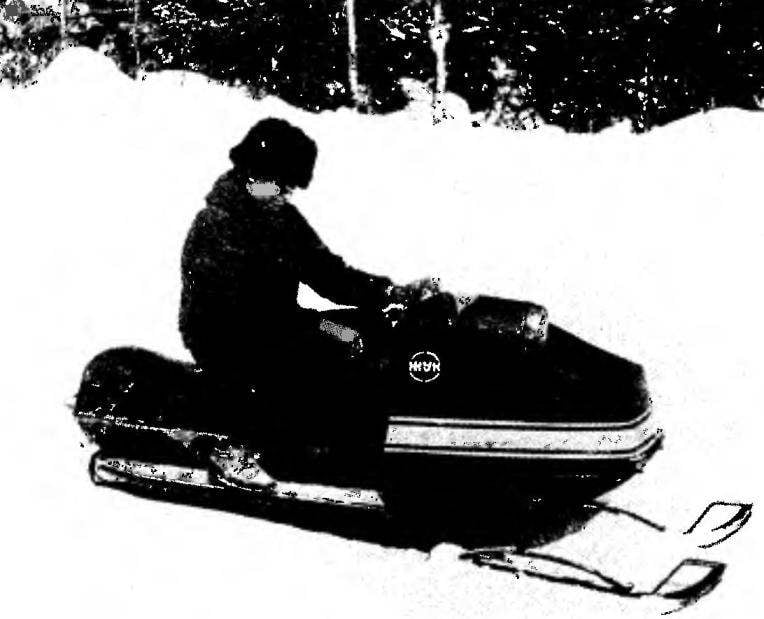TRANSMISSION. From the drive sprocket (z = 14)the main transmission of the engine torque chain PR-12,7 is transmitted to the sprocket (z = 24) input shaft reverse gear. Last(its ratio 1:1,64) — boat motor CM-500V. On the secondary shaft of the gearbox fixed sprocket (z = 16), from which a chain PR-15 torque is transmitted to the sprocket(z = 20) the drive shaft of the caterpillar. It also has two textolite sprocket (z = 9) included his teeth in the window of the track and forcing it to move.
The body of the snowmobile is assembled using arc welding of pre-manufactured components and parts: the frame of the snowmobile, frame, gearbox, tunnel, trunk, instrument panel, underbody, engine compartment, running boards and more. Welding was conducted dotted — tack. The necessary rigidity of the hull due to both strength characteristics of the materials used and its structural features (ribs, ribbing, lining, etc.).

The layout of a snowmobile:
1 — headlight (brand FG-50G); 2 — fuel tank (from a moped “Riga-12”); 3,13 – bushing the steering shaft; 4 — reverse gear; 5 — control lever reverse gear; 6 — handle of the starting device of the engine; 7 — compartments of the trunk; 8 — rear; 9 — the mechanism of track tension; 10 — cart reference; 11 —pedal shifter; 12 — thrust gear; 14 — gimbal steering shaft; 15 — pull steering, the longitudinal; 16 — pull steering, transverse; 17 — pin ski; 18 — silencer; 19 — pipe exhaust; 20 — engine (from a motorcycle MMVZ-3.111); 21 — the lever of the launcher; 22 — cord launcher.
Kinematic scheme of transmission:
1 — engine; 2 — engine sprocket (z = 14, t = 12,7); 3 — sprocket gearbox, small (z = 16, t = 15); 4 — sprocket drive shaft caterpillars (z = 20,t = 15); 5 — star tracks (z = 9, 2); 6 — caterpillar; 7 — reverse gear (t = 1,64); 8 – sprocket reverse^ reducer, large (z = 24, t=12,7).
Transmission of a snowmobile:
1 — the fixing points of the engine; 2 — engine; 3—asterisk engine; 4,9—sprocket gearbox; 5 reverse gear; 6 — sprocket tracks; 7,15 — rollers; 8 — tracks; 10 — sprocket drive shaft caterpillars; 11,13 — chain; 12 — the mechanism of a tension of a leading chain; 14 — a shaft caterpillar, senior; 16—axle support; 17 the mechanism of a tension of caterpillars; 18 — bearing lead and guide shafts of the caterpillar.
The layout of the body of the snowmobile:
1 — instrument panel (steel, sheet s2); 2 — clamp tank, a stationary part; 3 — M6 bolt (2 PCs); 4 — clamp tank, detachable part; 5 — mount the reverse gear (steel, strip 40×5); 6 — screw M 12×1,5 tension the drive chain; 7 — frame reverse gear (tube 27×3); 8 axle duplicera lever; 9 — bushing ski pins; 10 — axle steering rocking; 11 — bracket engine mounts, front; 12 the bottom of the engine compartment (steel, sheet s2); 13 — air intake; 14 cross member (tube 27×3); 15 — rivet hollow (tube 5×3); 16 — rib (steel, sheet s4, 2); 17 — bumper (rubber); 18 — pad (steel, strip 30×1,5); 19 — side panel of the engine compartment (steel, sheet s1,5); 20 — a lining (steel, sheet s2); 21 — loop fasteners of the support trolley (4 PCs); 22 — body frame (tube 27×3); 23 — foot pegs (steel, sheet s2); 24 — a bracket supporting trolley and the mechanism of track tension (steel, strip 64×4, 2); 25 — the tunnel (steel, sheet s2); 26 — trunk (steel, sheet s2); 27 handrail (pipe 15×11); 28 — partition boot (steel, sheet s2);

The design of the case.
The design of the case.
The engine hood of a snowmobile:
1 — lining; 2 — headlamp; 3 — glass windscreen; 4 — cable; 5 — a lock spring (2 PCs.)
The driver’s seat made of plywood 10 mm thick latex sponge and artificial leather upholstery, nailed to the plywood base obojnymi nails. The seat is pivotally mounted (leans to the right on two hinges), opening access to the trunk (the trunk lock has not).
Engine Bay protected on three sides by a rubber bumper trapezoidal cross-section, riveted to the sidewall of the compartment tubular rivets with a pitch of 50 mm using a steel tape overlay. The front bumper is slotted in three slotted holes-air intake for ventilation of the engine compartment. In addition, the pegs flush with the tubes of the frame of a snowmobile with wooden planks attached to the hull bottom with screws. On top of the straps have the rubber Mat and nailed him with small nails. Finally, the hood is equipped with a windscreen, and the caterpillar tunnel in the back covered by a rubber flap.
The HOOD is made of steel sheet of thickness 1.5 mm by using arc welding. It mounted directional spotlight (with a cable connecting it to the electrical grid) and the windshield. The hood is mounted on the bumper and attached to the body of a snowmobile with two spring locks.
V. PETROV, Krasnoyarsk Krai
 “I live in a remote Siberian village, which last year was 370 years. Near the river Angara. This is the Central district of Krasnoyarsk region, where winters with strong frosts and heavy snow covering the earth-mother seven months of the year. In such climatic conditions as it is not a sin to have a snowmobile.
“I live in a remote Siberian village, which last year was 370 years. Near the river Angara. This is the Central district of Krasnoyarsk region, where winters with strong frosts and heavy snow covering the earth-mother seven months of the year. In such climatic conditions as it is not a sin to have a snowmobile.

